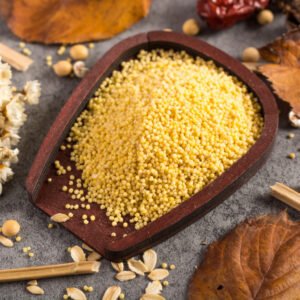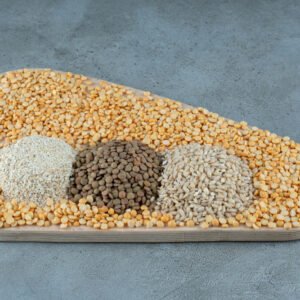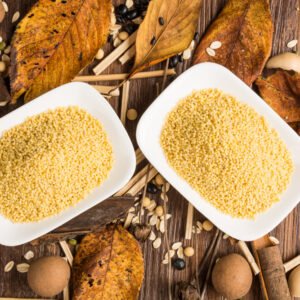Yellow millet has become one of the most sought-after grains in global markets, particularly as consumers shift toward healthier food choices. Whether you’re sourcing this ancient grain for food production, animal feed, or export purposes, understanding the technical specifications is essential for making informed purchasing decisions.
This guide breaks down the eight most critical yellow millet specifications that directly affect quality, storage, and end-use applications. Let’s explore what separates premium-grade millet from average product.
Also Read:- Yellow Corn: Nutrition, Uses, and Health Benefits
Why Yellow Millet Specifications Matter
Before diving into specific parameters, it helps to understand why these specifications exist. Yellow millet, primarily referring to proso millet (Panicum miliaceum), is valued for its nutritional profile and versatility. But quality varies widely depending on growing conditions, harvest timing, and post-harvest handling.
Buyers who ignore these specifications risk receiving grain that spoils quickly, fails to meet food safety standards, or underperforms in manufacturing processes. That’s why CMS Industries and other reputable suppliers maintain strict quality controls throughout sourcing and distribution.
1. Moisture Content: The Foundation of Quality
Moisture content ranks as the single most critical specification for yellow millet. This measurement determines shelf life, susceptibility to mold, and overall product stability.
Standard Moisture Levels
For safe storage, yellow millet should contain 13 percent moisture or less. Grain harvested at higher moisture levels requires artificial drying to prevent spoilage. During harvest, proso millet typically comes off the field at 15 to 20 percent moisture.
Why This Matters
Grain stored above 13 percent moisture creates an environment for mold growth, bacterial contamination, and heat damage. These conditions lead to rancidity, off-flavors, and nutritional degradation. Buyers should always request moisture testing documentation before finalizing large purchases.
Test methods include electronic moisture meters or oven-drying procedures. Both provide accurate readings when properly calibrated.
2. Protein Content: Nutritional Value Indicator
Protein content serves as a key quality marker for yellow millet. This specification directly affects the grain’s value in both human food and animal feed applications.
Expected Protein Ranges
Quality yellow millet typically contains between 8 and 11 percent protein on a dry weight basis. Research shows that different varieties can range from 8.05 to 10.46 percent depending on genetic characteristics and growing conditions.
Application Considerations
Higher protein content increases the grain’s nutritional density. Food manufacturers targeting health-conscious consumers often seek yellow millet with protein levels at the upper end of this range. Animal feed producers balance protein content with cost considerations.
When sourcing from agricultural suppliers like CMS Industries, request certificates of analysis that include protein testing results. These documents verify that the grain meets your specific application requirements.
3. Test Weight: Density and Fill Quality
Test weight measures the weight of grain per unit volume, typically expressed in pounds per bushel or kilograms per hectoliter. This specification indicates kernel density and overall fill quality.
What Good Test Weight Means
Higher test weight generally correlates with better kernel development, lower chaff content, and improved milling characteristics. Well-filled kernels produce more usable grain with less waste.
Proso millet with poor test weight often contains immature kernels, excessive foreign material, or damage from weather stress. These factors reduce milling efficiency and final product yield.
Practical Impact
Food processors pay premium prices for yellow millet with higher test weight because it yields more flour or whole grain product per ton of raw material. The specification becomes particularly important for export markets where buyers expect consistent quality.
4. Foreign Material and Purity Standards
Purity specifications define acceptable levels of foreign material in yellow millet shipments. Foreign material includes weed seeds, chaff, dirt, stones, and other non-grain components.
Grade Standards
Professional grading systems classify yellow millet into numbered grades based on purity. No. 1 grade typically allows minimal foreign material, while lower grades permit higher percentages. Most food-grade applications require grain with less than 2 percent foreign material.
Health and Safety Concerns
Beyond affecting yield, foreign material can harbor pests, introduce allergens, or damage processing equipment. Stones and metal fragments pose particular risks in milling operations.
Buyers should specify acceptable foreign material limits in purchase contracts. Reputable suppliers conduct thorough cleaning to meet these standards before shipment.
5. Kernel Size and Uniformity
Kernel size affects both processing efficiency and end product quality. Yellow millet seeds are naturally small, with approximately 80,000 seeds per pound, but size still varies between lots.
Size Categories
While standardized size classifications exist for some grains, yellow millet grading focuses more on uniformity than absolute size. Uniform kernels mill more evenly, cook consistently, and produce better-looking final products.
Processing Implications
Food manufacturers using whole yellow millet prefer uniform kernel size because it ensures even cooking. Flour producers find that uniform kernels reduce waste during milling and produce more consistent particle sizes.
Size variation within a lot often indicates mixed varieties or harvest from multiple fields with different maturity dates. This inconsistency can create processing challenges.
6. Color Classification and Appearance
While called yellow millet, proso millet kernels actually range from white and cream to yellow, orange, red, and even brown or black. Color affects market value and end-use applications.
Market Preferences
White and cream-colored varieties dominate commercial production in major growing regions. These lighter colors appeal to consumers who prefer mild-tasting grain products. Yellow varieties follow in popularity.
Food manufacturers often specify color requirements based on their target products. Darker varieties may be unacceptable for applications where light color is desirable.
Quality Indicators
Beyond aesthetic preferences, color can indicate grain condition. Discoloration may signal weather damage, aging, or improper storage. Fresh, properly stored yellow millet maintains bright, uniform color.
CMS Industries sources yellow millet varieties that meet international market standards for color and appearance, ensuring consistent quality for diverse applications.
7. Germination Rate and Viability
Germination rate matters primarily for seed buyers, but it also serves as a general quality indicator for food-grade grain. This specification measures the percentage of kernels that can produce viable plants.
Testing Standards
Laboratory germination tests place seeds in controlled conditions and count how many sprout within a specified period. Food-grade yellow millet doesn’t require high germination rates, but extremely low rates may indicate age or damage.
Indirect Quality Signal
Grain that has lost viability often shows other quality problems. Heat damage, excessive moisture during storage, and pest infestation all reduce germination capacity while affecting other quality parameters.
Buyers planning to use yellow millet for sprouting or malting applications should specifically request germination testing and set minimum acceptable rates.
8. Microbial and Contaminant Limits
Food safety specifications define acceptable levels of microbial contamination and harmful substances in yellow millet. These requirements have become increasingly strict as food safety regulations evolve globally.
Key Concerns
Testing typically covers total bacterial counts, mold and yeast levels, mycotoxins (particularly aflatoxins), and pesticide residues. Export markets often impose specific limits that sellers must document through certified laboratory testing.
Prevention Through Proper Handling
Most contamination problems trace back to field conditions or post-harvest handling. Proper drying, clean storage facilities, and pest control programs prevent microbial issues. Buyers should ask suppliers about their quality control procedures and request test certificates.
Organic yellow millet requires additional certification to verify that no synthetic pesticides or fertilizers were used during production. This specification adds value for buyers targeting organic food markets.
Making Informed Purchasing Decisions
Understanding these eight yellow millet specifications empowers buyers to evaluate suppliers objectively and negotiate fair prices. Quality grain commands premium pricing, but the investment pays off through better yields, longer shelf life, and superior end products.
When sourcing yellow millet, create a specification sheet listing your exact requirements for each parameter. Share this document with potential suppliers and request certificates of analysis for verification. This approach eliminates ambiguity and protects both parties.
Working with established agricultural product suppliers streamlines the purchasing process. Companies like CMS Industries maintain quality documentation and understand international trading standards, making them reliable partners for consistent supply.
The Bottom Line
Yellow millet specifications aren’t just technical details. They represent the difference between grain that performs as expected and product that creates problems downstream. Moisture content, protein levels, test weight, purity, kernel characteristics, color, viability, and safety parameters all contribute to overall quality.
Whether you’re buying a single container or establishing a long-term supply agreement, never compromise on specification verification. Request documentation, ask questions, and consider on-site inspections for large purchases.
The global market for yellow millet continues growing as consumers discover this nutritious ancient grain. Buyers who master these specifications position themselves to capitalize on market opportunities while minimizing risk.
Connect with Quality Yellow Millet Suppliers
Ready to source premium yellow millet that meets your exact specifications? CMS Industries specializes in agricultural products including grains, pulses, and oilseeds backed by rigorous quality controls. Contact us to discuss your requirements and receive detailed product specifications for our yellow millet offerings.
Frequently Asked Questions About Yellow Millet Specifications
Q.What is the ideal moisture content for storing yellow millet?
Yellow millet should be stored at 13 percent moisture or less to prevent mold growth and maintain quality. Higher moisture levels create conditions for spoilage, rancidity, and pest infestation. Always verify moisture content through testing before accepting delivery or placing grain in long-term storage.
Q.How does protein content affect yellow millet value?
Protein content typically ranges from 8 to 11 percent in quality yellow millet. Higher protein levels increase nutritional value, making the grain more desirable for health-focused food applications. Animal feed buyers also consider protein content when formulating rations. Buyers should request certificates of analysis showing exact protein percentages.
Q.Why do buyers care about test weight in yellow millet?
Test weight measures grain density and fill quality. Higher test weight indicates well-developed kernels with less chaff and foreign material. This translates to better milling yields and more usable product per ton of raw grain. Food processors and exporters particularly value yellow millet with good test weight.
Q.What foreign material limits are acceptable for food-grade yellow millet?
Food-grade yellow millet typically contains less than 2 percent foreign material including weed seeds, chaff, dirt, and stones. Lower foreign material content reduces waste, prevents equipment damage, and meets food safety standards. Always specify acceptable foreign material limits in purchase contracts to avoid disputes.
Q.Does yellow millet color affect grain quality?
Color primarily affects market preferences rather than nutritional quality. White and cream varieties dominate commercial markets, followed by yellow types. However, discoloration in any variety may indicate weather damage, improper storage, or aging. Fresh yellow millet maintains bright, uniform color without dark spots or fading.




